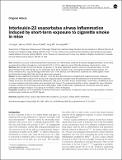| dc.contributor.author | Li, Jiu-rong | en_US |
| dc.contributor.author | Zhou, Wei-xun | en_US |
| dc.contributor.author | Huang, Ke-wu | en_US |
| dc.contributor.author | Jin, Yang | en_US |
| dc.contributor.author | Gao, Jin-ming | en_US |
| dc.date.accessioned | 2015-04-01T15:30:31Z | |
| dc.date.issued | 2014 | en_US |
| dc.identifier.citation | Li, Jiu-rong, Wei-xun Zhou, Ke-wu Huang, Yang Jin, and Jin-ming Gao. 2014. “Interleukin-22 exacerbates airway inflammation induced by short-term exposure to cigarette smoke in mice.” Acta Pharmacologica Sinica 35 (11): 1393-1401. doi:10.1038/aps.2014.91. http://dx.doi.org/10.1038/aps.2014.91. | en |
| dc.identifier.issn | 1671-4083 | en |
| dc.identifier.uri | http://nrs.harvard.edu/urn-3:HUL.InstRepos:14351307 | |
| dc.description.abstract | Aim: Interleukin-22 (IL-22) exhibits both proinflammatory and anti-inflammatory properties in various biological processes. In this study we explored the effects of exogenous recombinant IL-22 (rIL-22) on cigarette smoke (CS)-induced airway inflammation in mice. Methods: Male C57BL/6 mice were divided into groups: (1) CS group exposed to tobacco smoke for 3 consecutive days, (2) rIL-22 group received rIL-22 (100 mg/kg, ip), and (3) CS plus rIL-22 group, received rIL-22 (100 mg/kg, ip) before the CS exposure. The airway resistance (Rn), lung morphology, inflammatory cells in the airways, and inflammatory cytokines and CXCR3 ligands in both bronchoalveolar lavage (BAL) fluids and lung tissues were analyzed. Results: CS alone significantly elevated IL-22 level in the BAL fluid. Both CS and rIL-22 significantly augmented airway resistance, an influx of inflammatory cells into the airways and lung parenchyma, and significantly elevated levels of pro-inflammatory cytokines (TGFβ1 and IL-17A) and CXCR3 chemokines (particularly CXCL10) at the mRNA and/or protein levels. Furthermore, the effects of rIL-22 on airway resistance and inflammation were synergistic with those of CS, as demonstrated by a further increased Rn value, infiltration of greater numbers of inflammatory cells into the lung, higher levels of inflammatory cytokines and chemokines, and more severe pathological changes in CS plus rIL-22 group as compared to those in CS group. Conclusion: Exogenous rIL-22 exacerbates the airway inflammatory responses to CS exposure in part by inducing expression of several proinflammatory cytokines and CXCR3 ligands. | en |
| dc.language.iso | en_US | en |
| dc.publisher | Nature Publishing Group | en |
| dc.relation.isversionof | doi:10.1038/aps.2014.91 | en |
| dc.relation.hasversion | http://www.ncbi.nlm.nih.gov/pmc/articles/PMC4220081/pdf/ | en |
| dash.license | LAA | en_US |
| dc.subject | cigarette smoke | en |
| dc.subject | lung | en |
| dc.subject | airway inflammation | en |
| dc.subject | cytokine | en |
| dc.subject | IL-22 | en |
| dc.subject | IL-17A | en |
| dc.subject | TGFβ1 | en |
| dc.subject | CXCR3 chemokine | en |
| dc.title | Interleukin-22 exacerbates airway inflammation induced by short-term exposure to cigarette smoke in mice | en |
| dc.type | Journal Article | en_US |
| dc.description.version | Version of Record | en |
| dc.relation.journal | Acta Pharmacologica Sinica | en |
| dash.depositing.author | Jin, Yang | en_US |
| dc.date.available | 2015-04-01T15:30:31Z | |
| dc.identifier.doi | 10.1038/aps.2014.91 | * |
| dash.contributor.affiliated | Jin, Yang | |


